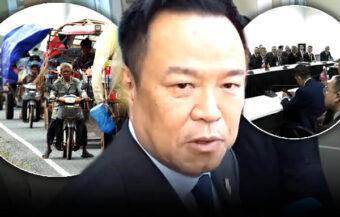Thailand’s reliance on foreign tourism is now a curse, warns a Hong Kong bond analyst. It fuels corruption, instability and stagnation. Arrivals are down 6.56%, Malaysia has overtaken, Chinese visitors have vanished and regional rivals race ahead in growth.
A top Hong Kong-based bond analyst has slammed Thailand’s economic dependence on foreign tourism, calling it a key reason the country has failed to address deep-rooted structural problems, including corruption, political instability, widening inequality and a debt-laden private sector choking growth. The warning comes as the kingdom faces a grim year for tourism and an economy losing ground to regional rivals, with Malaysia already overtaking it in foreign arrivals. Even its strongest sector is faltering, and chronic political dysfunction combined with entrenched corruption is fuelling a national malaise that, the analyst warns, is now eating into the country’s last reliable income stream: foreign tourism.

Thailand’s economy is facing serious and deep-rooted challenges despite its heavy reliance on foreign tourism. Many experts now say this dependence is actually a “curse in disguise.” Indeed, it masks deeper economic and political issues and stops the country from fixing its fundamental problems. Meanwhile, neighbouring Southeast Asian nations are growing faster, thus threatening Thailand’s long-held regional dominance.
Tourism has long been a mainstay of Thailand’s economy. The country attracts millions every year with its rich culture, affordable prices and well-established tourism infrastructure. However, many analysts now question the future sustainability of this tourism-driven model.
Tourism dependence has led to complacency and hindered diversification into high-value industry
Worut Promboon, a Hong Kong-based bond expert and World Bond Commissioner, recently criticised Thailand’s overdependence on tourism. He said, “Tourism revenue has created complacency among government and society.” As a result, Thailand has failed to push hard enough for economic diversification and reform.
Furthermore, Thailand remains trapped in low-value, traditional industries such as agriculture, electronics assembly and automotive manufacturing. Consequently, it has not made significant progress in technology, research or innovation, which are crucial for modern economies. This lack of development limits future growth potential.
Thailand’s GDP per capita has barely grown in recent years, reflecting a well-known problem economists call the “middle-income trap.” This trap means Thailand struggles to advance from middle-income to high-income status.
Meanwhile, neighbouring countries such as Vietnam, Indonesia, the Philippines and Malaysia have seen faster and steadier economic growth. Although their average incomes are still lower than Thailand’s, they are rapidly closing the gap. Therefore, many experts now predict these countries may soon surpass Thailand economically. This trend should concern Thai policymakers and investors alike.
Corruption, poor education, inequality and debt are driving Thailand deeper into a structural economic trap
Several key problems hold Thailand back. First, political instability and corruption reduce investor confidence and policy continuity. Second, the education system is outdated and fails to prepare the workforce for new industries. Third, the population is ageing rapidly, increasing social welfare costs.
Additionally, inequality remains high, while private sector borrowing has reached a ceiling. Many Thai families have limited spending power, which weakens domestic demand. As a result, many leading Thai firms have started to look abroad for growth opportunities.
Foreign investors have noticed these worrying trends. From their perspective, Thailand’s low growth and lack of structural reforms send a negative signal. Thus, Thailand has become less attractive for international bond investors despite low yields.
Mr. Worut emphasises that these issues are not short-term but deep and long-lasting structural problems. Accordingly, solutions require institutional reforms, improving labour skills and economic diversification beyond traditional patronage networks. However, the constant inflow of tourism revenue has made both the government and many citizens complacent. They believe no major changes are needed.
According to Mr. Worut, this complacency is a “barrier for national development.” It contrasts sharply with the concept of an “inclusive economy,” where the majority of people participate and benefit from economic growth.
Thailand is failing to meet tourism targets as Chinese arrivals fall sharply and market focus shifts
Tourism remains a vital pillar of Thailand’s economy, especially as manufacturing struggles. Nonetheless, despite this, the country is also losing this battle. For instance, it has now been overtaken by Malaysia, and in the course of 2025, foreign tourism arrivals have fallen precipitously.
Significantly, Malaysia saw a 20.4% surge in arrivals in the first five months of 2025, receiving 16.94 million visitors, well ahead of 14.36 million for Thailand.
The Tourism Authority of Thailand (TAT) previously set an ambitious goal of 40 million visitors for 2025. It particularly aimed to attract 11 million Chinese tourists, matching the pre-pandemic level from 2019.
However, by August 3, 2025, these targets appeared completely out of reach. Foreign tourist arrivals in 2025 actually fell 6.56% compared to 2024. Chinese arrivals dropped sharply after February.
Consequently, some Thai planners now suggest abandoning hopes of recovering the Chinese tourist market this year. Indeed, some are urging that Thailand abandon its focus on China altogether.
New tourism markets are growing, but remain insufficient to offset the sharp decline in Chinese visitors
The overall tourism revenue target for 2025 is ฿3.5 trillion. Last year, 35.5 million tourists generated about ฿1.66 trillion in revenue. However, the country missed the ฿2 trillion target, something that was achieved in 2019. This year, the best-case scenario predicts only around 34 million visitors.
In 2024, just 6.7 million Chinese tourists visited Thailand, far below the 11 million arrivals in 2019. Slower economic growth in China partly explains this sharp decline. By early August 2025, only 2.73 million Chinese tourists had arrived.
To compensate, the TAT sought to attract more tourists from India and Europe. So far, they have seen notable increases from European and Western visitors. Nevertheless, these new visitors have not yet made up for the sharp Chinese shortfall.
At the same time, the Thai government has faced criticism for its weak response to worsening air pollution. Addressing air pollution requires stricter enforcement against agricultural burning and industrial emissions.
Air pollution and safety issues threaten tourism recovery while political tensions add further instability
Air pollution poses a serious and growing threat. Thailand regularly experiences dangerously high levels of PM2.5 toxic dust. This pollution harms public health and the environment.
Clean air and tourist safety are crucial for Thailand’s tourism industry to thrive. However, the sector faces challenges including an ageing visitor base and a lack of fresh investment.
Nevertheless, some independent Chinese tourists familiar with Thailand continue to visit. These travellers tend to avoid polluted areas and take safety precautions.
Following a public outcry in China in January 2025, Thailand launched crackdowns on scammer activity in Myanmar and Cambodia. This crackdown is believed to have contributed to the Thai-Cambodian border conflict that erupted in July.
Cambodian Prime Minister Hun Sen’s government has faced criticism from the United Nations and Amnesty International for its complacency toward these criminal networks. No wonder they are linked to an estimated 50-60% of Cambodia’s GDP when laundered.
The ongoing conflict presents yet another obstacle to improving foreign tourism this year.
Cross-border pollution and weak cooperation threaten Thailand’s ability to maintain long-term tourism
The main pollution sources include farmers burning sugarcane fields and factories releasing dirty air. Pollution from neighbouring countries and seasonal weather patterns worsen the problem further during certain months.
The Thai government has repeatedly called for regional cooperation to tackle cross-border pollution. However, critics argue that serious collaboration remains lacking.
Clean air is an essential factor for many tourists. Therefore, failure to improve pollution levels risks further declines in visitor numbers.
No more surprises or shocks. Thai foreign tourism players warn of a bad year with arrivals down 6.56%
Thailand’s heavy reliance on foreign tourism has created a short-term economic cushion. However, this same reliance has discouraged urgent economic reforms. The country’s chronic problems—political instability, corruption, an ageing population, educational weaknesses, and rising inequality—remain unresolved.
Without tackling these core issues, Thailand risks losing ground to its ASEAN neighbours. Countries like Vietnam and Indonesia invest more heavily in technology, innovation and inclusive growth.
Undoubtedly, Thailand’s future success depends on embracing structural reforms, upgrading workforce skills and diversifying its economy. If these steps are delayed, tourism dependence will continue to trap the country in stagnation.
Join the Thai News forum, follow Thai Examiner on Facebook here
Receive all our stories as they come out on Telegram here
Follow Thai Examiner here
Further reading:
Thaksin does not rule out joining talks in US as Thai team finalises plans. They fly out on Thursday


















